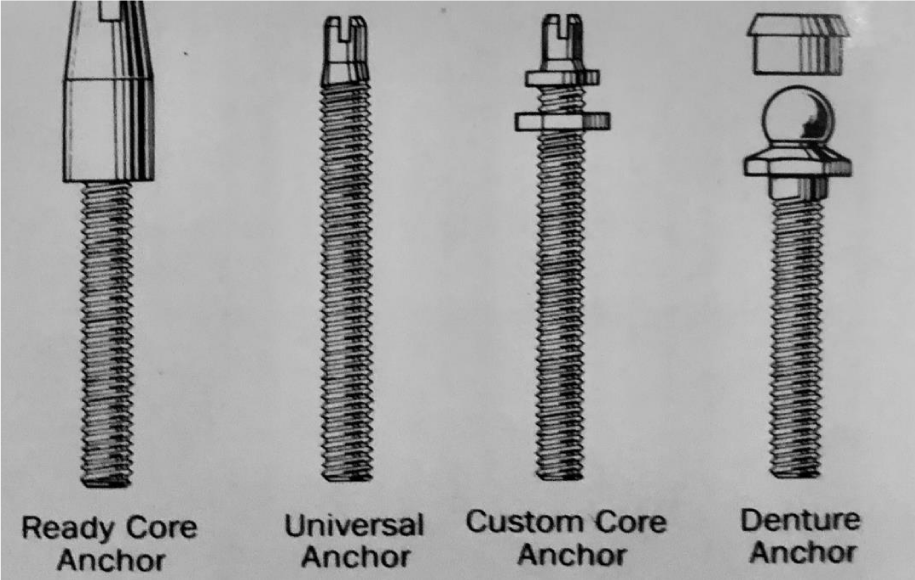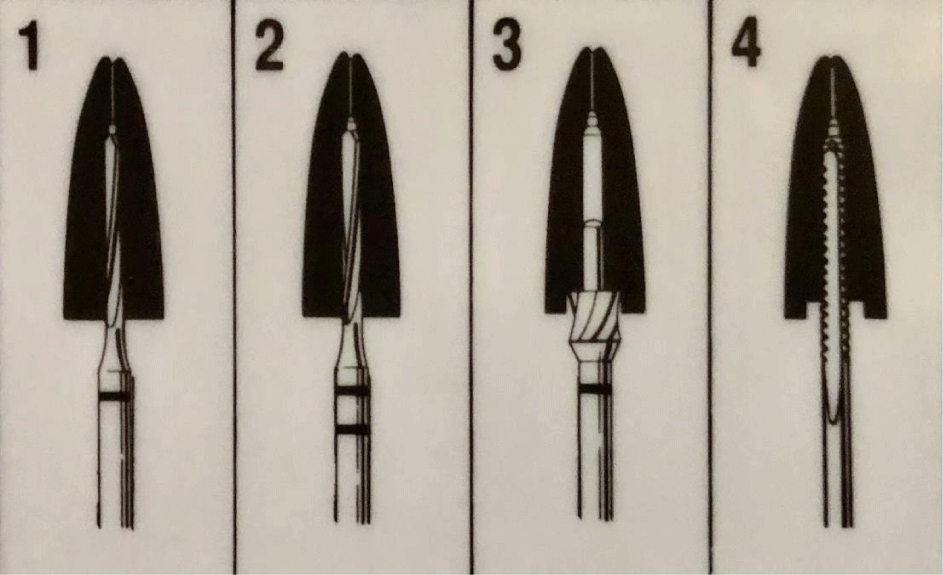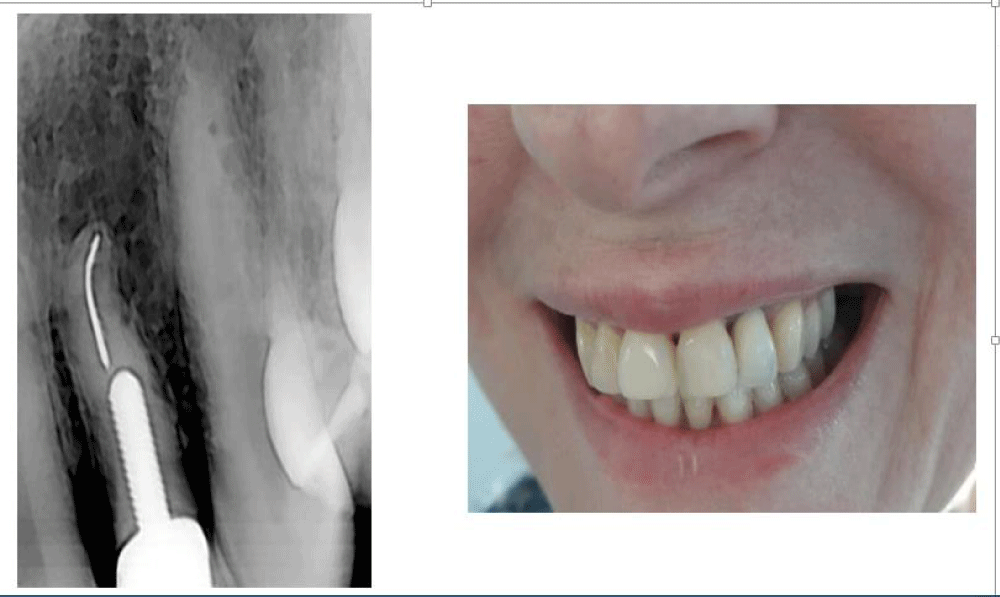Journal of Dental Problems and Solutions
Do Not Extract Teeth which you could Restore Perhaps you do?
Peter F Kurer*
Cite this as
Kurer PF. Do Not Extract Teeth which you could Restore Perhaps you do?. J Dent Probl Solut. 2024;11(2):020-023. Available from: 10.17352/2394-8418.000128Copyright License
© 2024 Kurer PF. This is an open-access article distributed under the terms of the Creative Commons Attribution License, which permits unrestricted use, distribution, and reproduction in any medium, provided the original author and source are credited.The Kurer Anchor System, a once widely used dental restoration method, offered a solution for retaining root canal posts in treated teeth. Despite its success in preserving natural teeth and providing a cost-effective alternative to implants, the system's popularity waned due to changes in the dental industry. This paper revisits the Kurer Anchor System, examining its clinical efficacy, economic advantages, and potential integration with modern dental practices. Emphasizing the importance of implant surface cleanliness, the paper advocates for the revival of the Kurer Anchor System in contemporary dentistry. The conclusion underscores the need for educating dental professionals about this system's benefits and proper application.
Introduction
Many years ago, there was a tooth restoration method known as post crowns.
If a tooth had had root canal treatment, it was restored by cementing a post into the tooth root canal. The post projected into the crown space and a crown was cemented over that projection. A post-crown. Many post fell out of the tooth [1].
I was working as a dentist in Manchester, together with my father and brother both dentists. Not only did many of my posts fall out, but some of their posts also fell out. They were recemented, but many of them fell out again!
I saw that a post crown retention problem existed !
In the school I attended, we had a very good woodwork metal work teacher.
We were taught to use a small instrument to cut a thread into the wall of a cavity.
A thread cutter which is called a TAP.
When I saw many posts fall out of root canals the thought occurred to me, I wonder if I could cut a thread into the wall of the root canal?
When next I extracted a tooth, I bought a thin thread cutter and very narrow drill to remove the contents of the root canal and then tried to cut a thread into the wall of the root canal. It was very easy and very simple.
The thought occurred to me that I had discovered something very important. Something that could stop posts falling out of root canals. Something that could benefit my colleagues. Cutting a thread into the wall of a root canal.
I invented a dental item which became known as:-
Discussion
The kurer anchor system [2].
I obtained nine patents around the world.
I found a precision engineering company, very happy to place threads into thin stainless-steel rods. The foundation of manufacturing my invention.
I now needed drills and other instruments and containers, so that put together they formed an item which could be sold [3].
I found good dental companies prepared to try and sell my Anchor System in Europe. Cottrell & Co. in the UK. Hager & Werken in Germany, were two very successful companies selling the Anchor System. After 10 years on the market in Europe, I eventually found Teledyne Getz Dental in the USA, Morita & Co. in Japan, who started selling my product in their Country and around the world [4].
The Kurer Anchors were now manufactured in 4 different POST diameters.
Each diameter of Anchor required matching diameter of cutting tools.
Different heads soon became available on the threaded posts, coping with different dental problems Figure 1.
Starter reamer in handpiece Figure 2.
- Starter reamer
- Width reamer, turned by hand so it does not become too wide
- Root facer.
- Cut the thread with thread cutter by hand.
Accuracy & simplicity
I formed a packaging company which obtained the square plastic boxes to contain, the instruments and the Anchors, and large packaging boxes to carry the plastic boxes. My staff had to pack the instruments and the Anchors in a plastic box together with 6 or12 or 18 Anchors. Soon my packaging company was working very hard in a place I rented, near to my surgeries.
Our largest selling company ultimately became Teledyne Getz, in the USA.
After two years of amazing selling they gave us a standing order which started with 1,000 kits per month. A few years later that extended to 2,000 kits a month.
When the Anchor System was selling in 50 countries, after 23 years on the market, I was getting old and I felt it was time to think of selling out.
Who could be interested in buying my Kurer Anchor System? I thought of approaching some distributers and ask them if they were interested. My packing and distributing company, now had twelve packers, all kept extremely busy with an excellent manageress.
Teledyne Getz my American distributer was interested in owning this Product.
I sold out to Teledyne Getz, U.S.A. with no problems, OBTAINING more money than I ever thought I would see. Success – Success - Success!
I signed an agreement that I would continue to support Teledyne Getz just as I did previously. I was happy to help and do whatever they wanted me to and they told me they would pay extra for new additional work. Lecturing aboard was an item.
What went wrong ? What happened ?
Teledyne Getz was owned by an enormous Parent Corporation who owned fifty or more companies. The Parent Corporation eventually went into Bankrupsy.
Bankruptcy which had nothing to do with Teledyne Getz.
Teledyne Getz struggled for a few more years but then also went into liquidation.
They Closed Down.
The UK manufacturers of the Anchor System, Sabre Dental, went to the USA to try and find another company to sell this product. They placed The Kurer Anchor System in the hands of a very small dental company, which I had never heard of. Sales went down and down and have never recovered. They never advertised.
When the Kurer Anchor System had been on the market for only 4 years, Quintessence Publishing Co. invited me to write a book on the Kurer Anchor System. I did this, it took me four years and contains 500 coloured photographs of restorations. 6 world famous Professor offered to contribute chapters for my book and did so.
They are:-
Prof. H. Bottger. Dusseldorf University. West Germany.
Prof. A.A, Caputo and J.P. Standlee, School of Dentistry, California.
Prof. E.C. Combe. Turner Dental School, Manchester.
Prof. B.W. Darveil. Hong Kong.
Prof. A. Yamashita. Okayama University Japan.
If six world famous Professors all write in support of the Kurer Anchor System,
What chance is there of this dental product being otherwise than excellent?
Two years after Quintessence Publishing Co, published the book in English, they published the book in German and two years later it was published in Japanese!
My next stage in promoting the use of the Anchor System was my being invited around the world to lecture on restoration of endodontically treated teeth!
I lectured in Germany a few times for eight years.
I lectured in the USA three times a year for 32 years.
I lectured in Japan three times a year for 23 years. Also very many other countries including twice in Russia, Argentina, Brazil and other countries.
So what went wrong ?
The American Corporation which owned over 50 companies went into liquidation.
A few years later Teledyne Getz the company to whom I sold my Kurer Anchor System closed.
The English company who was manufacturing the Kurer Anchors went off to the U.S.A. To find a successor to Teledyne Getz. They handed the sale off to an American Corporation which was small and I had never come across. The sales went down and down, not only in the USA but the new sales corporation had no contacts with other Dental product sales companies in other Countries as had Teledyne Getz ! [5].
The other new item which helped to kill my Kurer Anchor System was the arrival of implants! [6].
When implants first became available, they were smooth as posts had been. Soon they changed to being threaded.
Why should any dentist extract a tooth and place an implant. The tooth could have been extracted years ago.
The attraction to extracting a tooth and placing an implant is I believe, the profit the dentist is likely to make.
When placing a Kurer Anchor, the dentist might earn £200 per Anchor. When placing an implant the dentist was likely to earn £2,000 per implant. Why place a post? [7-9].
The two items which killed my Anchor System was firstly Teledyne Getz parent corporation going Bankrupt, which had nothing to do with any dental product [10].
Secondly the arrival of Implants, increasing the dentist’s profit by 200 % much more than when DENTISTS are placing posts!
I hope that this precious Dental Magazine, will find a manufacturer able and happy to manufacture threaded posts. My patents, have long expired.
Manufacture Threaded Posts which over very many years saved millions of teeth. Every patient should be sure that every root, that can be rebuilt will not be extracted and will be restored! Figure 3.
My daughter’s front left lateral I restored when she was 18. She is now 66 and the tooth is still there.
Conclusion
In conclusion, the Kurer Anchor System remains a viable and valuable option in dental restoration, offering economic and clinical advantages over traditional implants [11,12]. By integrating modern advancements and emphasizing the importance of preserving natural teeth, the system can be successfully revived in contemporary practice. It is crucial to educate dental professionals about the Kurer Anchor System's benefits to ensure its widespread adoption and continued success. The take-home message is clear: dentists should reconsider the extraction of teeth that could be restored using the Kurer Anchor System, thus providing a cost-effective and less invasive alternative for patients [13-15].
- Esposito M, Grusovin MG, Polyzos IP, Felice P, Worthington HV. Interventions for replacing missing teeth: dental implants in fresh extraction sockets. Cochrane Database Syst Rev. 2012;2(2). Available from: https://pubmed.ncbi.nlm.nih.gov/20824846/
- Lang NP, Jepsen S. Implant surfaces and design (Working Group 4). Clin Oral Implants Res. 2009;29(Suppl 4):228-231. Available from: https://pubmed.ncbi.nlm.nih.gov/19663968/
- Rocci A, Martignoni M, Gottlow J. Immediate loading in the maxilla using flapless surgery, implants placed in predetermined positions, and prefabricated provisional restorations: a retrospective 3-year clinical study. Clin Implant Dent Relat Res. 2003;5(Suppl 1):29-36. Available from: https://pubmed.ncbi.nlm.nih.gov/12691648/
- Yuan Q, Lee DJ, Afshari FS, Teich ST. Dental implants: An evolving discipline. J Prosthet Dent. 2019;121(5):699-710.
- Smeets R, Henningsen A, Jung O, Heiland M, Hammächer C, Stein JM. Definitions, etiology, prevention and treatment of peri-implantitis: a review. Head Face Med. 2014;10(1):34. Available from: https://pubmed.ncbi.nlm.nih.gov/25185675/
- Zitzmann NU, Berglundh T. Definition and prevalence of peri-implant diseases. J Clin Periodontol. 2008;35:286-291. Available from: https://pubmed.ncbi.nlm.nih.gov/18724856/
- Albrektsson T, Zarb G, Worthington P, Eriksson AR. The long-term efficacy of currently used dental implants: a review and proposed criteria of success. Int J Oral Maxillofac Implants. 1986;1(1):11-25. Available from: https://pubmed.ncbi.nlm.nih.gov/3527955/
- Vere J, Bhakta S, Patel R. The management of peri-implantitis: a wide variety of treatments. Evid Based Dent. 2021;22(1):12-14.
- Pjetursson BE, Thoma D, Jung R, Zwahlen M, Zembic A. A systematic review of the survival and complication rates of implant-supported fixed dental prostheses (FDPs) after a mean observation period of at least 5 years. Clin Oral Implants Res. 2012;Suppl 6:184-217. Available from: https://pubmed.ncbi.nlm.nih.gov/23062125/
- Chen S, Darby I. Dental implants: maintenance, care and treatment of peri-implant infection. Aust Dent J. 2003;48(4):212-220. Available from: https://pubmed.ncbi.nlm.nih.gov/14738123/
- Jivraj S, Chee W, Corrado P. Treatment planning of the implant-supported restoration. Br Dent J. 2006;201(5):261-279. Available from: https://pubmed.ncbi.nlm.nih.gov/16960607/
- Papaspyridakos P, Chen CJ, Chuang SK, Weber HP, Gallucci GO. A systematic review of biologic and technical complications with fixed implant rehabilitations for edentulous patients. Int J Oral Maxillofac Implants. 2012;27(1):102-110. Available from: https://pubmed.ncbi.nlm.nih.gov/22299086/
- Schwarz F, Derks J, Monje A, Wang HL. Peri-implantitis. J Clin Periodontol. 2018;45(Suppl 20). Available from: https://pubmed.ncbi.nlm.nih.gov/29926484/
- Yao CJ, Cao C, Bornstein MM, Mattheos N. Patient-reported outcome measures of edentulous patients restored with implant-supported removable and fixed prostheses: A systematic review. Clin Oral Implants Res. 2018;29(Suppl 16):241-254. Available from: https://pubmed.ncbi.nlm.nih.gov/30328202/
- Zurdo J, Romão C, Wennström JL. Survival and complication rates of implant-supported fixed partial dentures with cantilevers: a systematic review. Clin Oral Implants Res. 2009;20(Suppl 4):59-66. Available from: https://pubmed.ncbi.nlm.nih.gov/19663951/
Article Alerts
Subscribe to our articles alerts and stay tuned.
 This work is licensed under a Creative Commons Attribution 4.0 International License.
This work is licensed under a Creative Commons Attribution 4.0 International License.





 Save to Mendeley
Save to Mendeley
